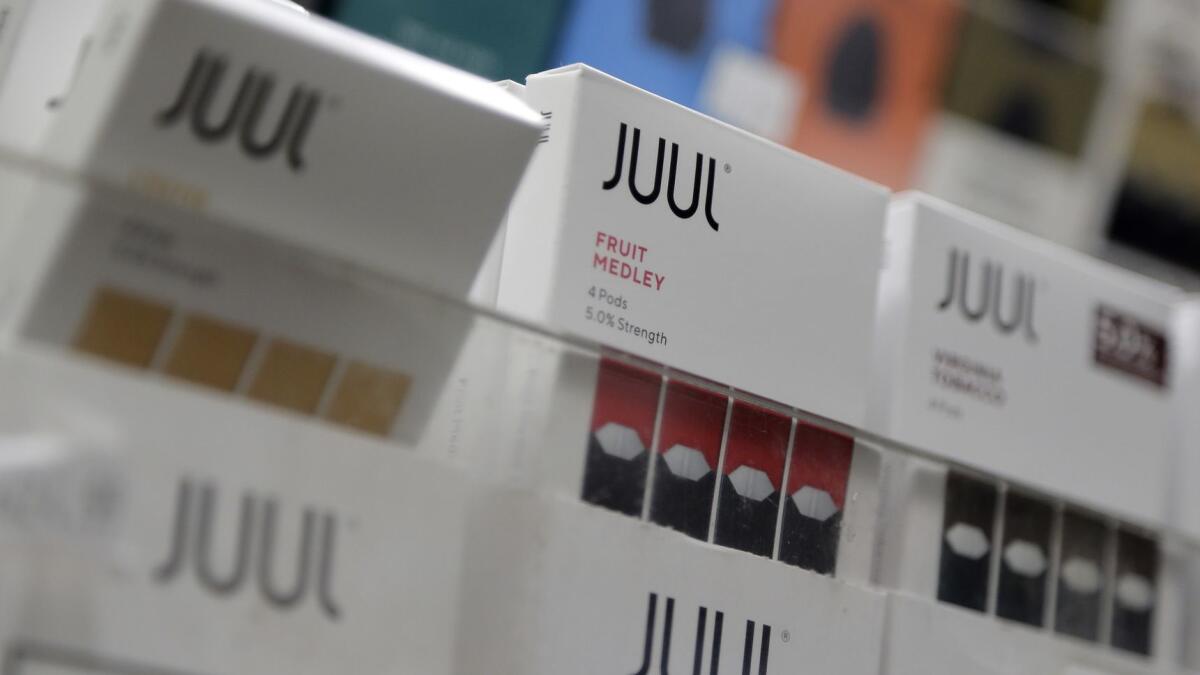Column: A tobacco company makes Juul’s founders billionaires while questions rise about their product’s safety

- Share via
Ever since their retail introduction about a dozen years ago, e-cigarettes have been at the center of a debate over their impact on public health.
We now can safely say the debate is over. E-cigs and the vaping they foster are a public health disaster in the making. We can draw this conclusion not from any scientific study, but from a single financial transaction: Altria, the nation’s largest tobacco company, just agreed to pay $12.8 billion for a 35% stake in San Francisco-based Juul, the leading e-cigarette marketer. The deal valued Juul at $38 billion and made its founders, Adam Bowen and James Monsees, billionaires.
Altria largely invests in markets with a capacity for addiction, abuse or dependency. Its products include cigarettes (Marlboro, for instance), smokeless tobacco, and wine and beer. It doesn’t invest in products with an eye toward their medical benefits. So now, e-cigarettes.
I’ve been warning the e-cigarette industry for more than a year that they needed to do much more to stem the youth trends.
— FDA Commissioner Scott Gottlieb
In acquiring its Juul stake, Altria, which is the U.S.-based remnant of the old Philip Morris international tobacco empire, is coming together with a company that seems to have taken lessons from its playbook about how to market an addictive product. One technique is to minimize its dangers; Juul says its “mission” is to help adult smokers kick the habit, and that it’s appalled that kids are using its devices to introduce themselves to nicotine.
In a similar vein, Altria says its investment fit with its mission to “achieve tobacco harm reduction.”
Altria’s investment may only intensify the debate among medical experts about the safety of vaping. A quick primer: E-cigarettes use a heating element to vaporize a nicotine compound for ingestion. They give users the desired nicotine kick without also delivering health-sapping and cancer-causing components of cigarette smoke, such as tar. But it’s nicotine that’s the addictive substance in tobacco.
Some experts consider e-cigarettes like Juul’s products to be promising devices for weaning smokers off tobacco. The degree to which smokers actually tend to give up cigarettes and make the transition to vaping is uncertain — some vapers continue smoking, too. Still, there seems little question that vaping is better for them than smoking — if they give up cigarettes.
The question is whether vaping is better than using nothing, and there medical opinion seems heavily tilted toward answering no.
Not long after e-cigs started on their path of popularity, public health officials were warning that the devices threatened to “renormalize” smoking after decades of largely successful efforts to make the habit socially unacceptable.
What raises hackles among public health officials is that vaping absolutely has taken off among schoolchildren. It’s easy to conceal the activity, in part because e-cigarettes like Juul’s resemble the pen drives that plug into laptop computers, albeit elongated into the size of a pack of chewing gum. They don’t emit the acrid stench of cigarettes that used to infuse the bathrooms of many a high school in the old days.
Vaping has now acquired the cool image among teens that used to attach to cigarettes. The conclusion that the vaping and tobacco industries, having joined forces, are creating a new generation of nicotine-addicted customers is inescapable.
According to a survey released this month by the University of Michigan, the percentage of 12th-graders who reported vaping nicotine in the previous 30 days rose to 21% in 2018 from 11% in 2017 — an increase that was “the largest ever recorded in the past 43 years for any adolescent substance use outcome in the U.S.” The survey’s results indicate that in 2018, 1 in 5 high school seniors vaped nicotine in the 30 days before being surveyed.
The figures are shocking. In 2001, some 29.5% of high school seniors reported having smoked cigarettes in the previous 30 days. This year, that figure has fallen to 7.6%, but 20.9% reported having vaped nicotine, for a total of 28.5% combined vaping and cigarettes — almost back up to the level of cigarettes alone in 2001.
As Kevin Drum of Mother Jones observes, the survey’s results indicate that “in just a few years, vaping has wiped out two decades of work getting teens to quit (or never start) cigarette smoking.”
Public health officials have reacted to the surge in teen vaping by reconsidering the government’s previously tolerant approach to the practice. Earlier this month, U.S. Surgeon General Jerome Adams issued an advisory calling e-cigarette use an “epidemic” among young people and calling for increased vigilance and education about its dangers.
“E-cigarette aerosol is not harmless,” he stated. “Nicotine exposure during adolescence can harm the developing brain — which continues to develop until about age 25. Nicotine exposure during adolescence can impact learning, memory, and attention. Using nicotine in adolescence can also increase risk for future addiction to other drugs.”
Food and Drug Administration Commissioner Scott Gottlieb also has taken a firmer stand on vaping. Acknowledging that he initially saw e-cigarettes as useful for smoking-cessation, he indicated in a Nov. 15 statement that their risks were threatening to outweigh their benefits.
“Any policy accommodation to advance the innovations that could present an alternative to smoking,” he said, “cannot, and will not, come at the expense of addicting a generation of children to nicotine through these same delivery vehicles. This simply will not happen. I will take whatever steps I must to prevent this.”
Gottlieb said that he’s considering accelerating the deadline for e-cigarette manufacturers to comply with FDA permitting rules for some of their products, which originally was set as far off as August 2022. The FDA also stepped up enforcement of regulations barring the sales of nicotine products to children and called on the industry to voluntarily end its marketing of flavored nicotine pods, which appeal especially to underage users.
“I’ve been warning the e-cigarette industry for more than a year that they needed to do much more to stem the youth trends,” Gottlieb said in September. “In my view, they treated these issues like a public relations challenge rather than seriously considering their legal obligations, the public health mandate, and the existential threat to these products. And the risks mounted. Well, I’m here to tell them that this prior approach is over.”
Both he and Adams specifically mentioned Juul in their warnings — an indication of the drawbacks of dominating an industry.
Juul likes to depict itself as a proactive warrior against youth vaping. It says its mission is to eradicate cigarette smoking by giving smokers a safer alternative. “We don’t want anyone who doesn’t smoke, or already use nicotine, to use Juul products,” CEO Kevin Burns said Nov. 13. “We certainly don’t want youth using the product. It is bad for public health, and it is bad for our mission.”
As of that day, Burns said, Juul would stop accepting retailers’ orders for mango-, cucumber-, fruit- and creme-flavored pods, and would tighten the age-verification procedures for sales from its website, where they still would be available. The company also said it would shut down its Facebook and Instagram accounts, because social media has been a prime tool for reaching young customers.
Burns didn’t make it all that clear, however, that Juul was under the gun from Gottlieb, who on Sept. 12 had given the company, along with other marketers, 60 days to give the FDA “robust plans on how they’ll convincingly address the widespread use of their products by minors,” with the explicit threat that the agency would come after the firms with enforcement proceedings if they failed.
Is it conceivable that Juul and the other e-cigarette makers were blindsided by their products’ popularity with impressionable youngsters? The company asks to be praised for never selling “flavors like Gummy Bear or Cotton Candy, which are clearly targeted to kids.” But fruit and creme flavors aren’t exactly adult tastes.
The public health disaster of “electronic nicotine delivery systems,” as e-cigs are technically designated, is already upon us. The industry skated for a few years, while regulators convinced themselves that the products were really for adults trying to quit smoking. Altria’s $12.8-billion investment in Juul exposes the lie at the heart of this claim. But it may be too late.
Keep up to date with Michael Hiltzik. Follow @hiltzikm on Twitter, see his Facebook page, or email [email protected].
Return to Michael Hiltzik’s blog.







